The countertop is the main work surface in the kitchen. It is subjected to various mechanical stresses, as well as temperature extremes, so it is important to choose this type of coating for the kitchen set correctly.

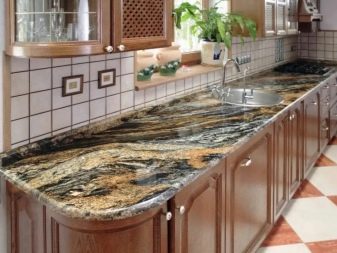
Selection rules
Choosing this coverage, It is important to know that the standard thickness is 40 mm. However, it is possible to find countertops with a thickness of 28 to 100 mm. To select the thickness of the product you need, need to build on what impact it will be exposed to.
Important when choosing are the dimensions of the room for which you need a countertop. In small kitchens of solid thickness, the countertop will look terrible.
The method of fastening the product to the kitchen set, and the general aesthetic appearance of the structure are also important. In addition to the fastening method itself, it is worth paying attention to its weight.
When choosing, you should take into account the material from which the countertop is made, because not only the price, but also the service life depends on it.


Modern countertops in the kitchen should be:
- moisture resistant;
- shockproof;
- comfortable;
- heat resistant.
The width of the countertops is usually 60 cm, but in some individual orders it can vary from 80 to 120 cm.
It is worth considering the shape of your kitchen set, as well as what equipment you are going to install. When refusing a solid plate and selecting countertops for a hob, it is worth remembering that they should have the same performance.




The dependence of the thickness of the product on its price is directly proportional, but the thicker the countertop, the stronger it is.


Materials
The most popular and widespread is chipboard and MDF. Worktops of such materials are usually made with a thickness of 38 mm and 28 mm.
Laminated boards come in various colors and textures, but they are not as durable as, for example, wood. However, the cost of countertops from them is much lower than from natural wood. And even in cases where they are made to order. The maximum length of a laminated board is from 3000 to 3500 mm. The width of such countertops is usually limited to 600 mm, therefore, it is worth remembering when ordering an individual kitchen project that products from this material cannot be built up.
MDF worktops will not work if you have a corner kitchen and have joints, since when combining such a surface, the junction is very noticeable and will be a weak link in the worktop. If moisture gets on the joint, it will begin to swell, which will lead to deformation and replacement of the countertop.
If you are not too limited in means and want your kitchen to look spectacular, it is worth taking a closer look at natural materials, such as wood or stone.
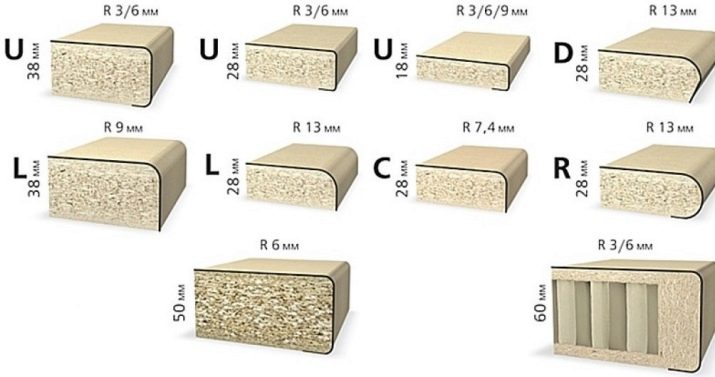
Wooden
Wooden tabletops are usually made from the following tree species:
- oak;
- beech;
- larch.
The wood is covered with special water-repellent agents to avoid its swelling from moisture. However, such a product requires special care, but it is forbidden to use household chemicals when cleaning. The standard thickness of a wooden table top is usually 20 mm, in some cases 40 mm. Sometimes, due to the nature of the kitchen, the countertop must be thinner. In this case, it is possible to make a product with a thickness of 18 mm.

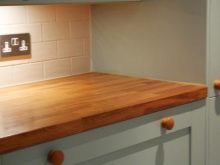

Made of natural stone
When choosing a table top made of natural stone, it is worthwhile to understand that it has a rather large dead weight, so the frame of the kitchen table, cabinet or floor cabinet should be solid and withstand loads of up to 80 kg per square meter. m The advantage of such countertops is their uniqueness in terms of drawing. The raw material for products is usually marble or granite. Usually, thickness varies from 20 to 30 mm for marble and 30-50 mm for granite. For marble countertops, the standard thickness is 26 mm.
The disadvantages of the material of stone include:
- high price;
- the formation of chips and small cracks;
- difficulty in leaving;
- the inability to get rid of certain types of pollution.
An excellent alternative to countertops made of natural stone will be products made of artificial stone. By its nature, artificial stone is a liquid polymer with various impregnations of colored granules. Due to the fact that it has a liquid base, it is used mainly in those places where rounded corners or a curved appearance of the countertop are needed.
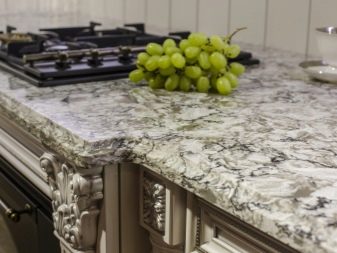

Algomerate
Another cheaper substitute for natural stone will be an algomerate. Its base also consists of liquid polymers, however, it includes crumbs from natural stones, for example, quartz or a border. According to its properties It is practically not inferior to natural material - only in hygroscopicity. But at the same time it is more durable material.

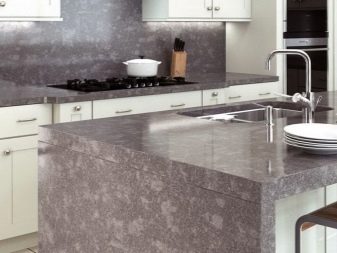
From acrylic
You can opt for an acrylic countertop. One of its advantages is that the joints between the parts of the headset are invisible. Such a product has no size restrictions, therefore using this material you can realize any idea of the designer and customer. The standard thickness of the sheet of such countertops is 12 mm, therefore, to give greater strength it is increased with plywood or chipboard.
In some cases, the choice of a kitchen worktop is rather unusual, for example, you can find such materials:
- glass;
- stainless steel
- ceramic tile.


Stainless steel
Choosing such a cover for a kitchen set, you can save, but at the same time not lose in the strength and durability of the product. Stainless steel products do not absorb grease and dirt, which makes it easy to clean them. The surface of such a countertop is glossy, which, if the lighting is correctly placed, will create a brighter kitchen - this will help the reflection of light from steel.
Often, such a coating is used in professional kitchens, which is explained by the simplicity of care and durability. When using such countertops in apartments, it is recommended to dilute the interior with natural wood in order to soften the overall situation.
Advantages of stainless steel products:
- durability;
- do not require special care;
- well withstand mechanical stress;
- are safe.


Glass
Glass countertops are rarely used, but create a special style in the interior. Their thickness should be at least 16 mm. Such products are made of durable tempered glass. Sometimes a substrate is used to give strength. A glass worktop can be a great highlight of the interior, as in the kitchen it becomes possible to make an entire composition in glass. In addition, the countertop can become an additional light source by attaching an LED strip to it.
Another option is to put photo printing on the glass. This will make the interior more original and unique.
Product advantages:
- safe
- wear resistant;
- easy to clean;
- resistant to temperature extremes.
However, the cost of such a product is quite high and depends on the type of glass.


Ceramic tile
The complexity of such a countertop is that it is difficult to choose the tile of the required size. Chipboard surfaces are usually revetted, therefore, for better adhesion, a primer is used, and then tile glue is applied. It is possible to use such a countertop 12 hours after laying the tiles. But experts recommend waiting a day for better drying of the glue and adhesion of the surfaces.


Combination in the interior
If you are the owner of a large and spacious kitchen, then you should opt for granite or marble countertops. Such a thick countertop will give the kitchen a noble appearance and will be a great addition to such interior styles as hi-tech or modern.

For interior in style country a natural complement will be a product made of wood, as it emphasizes the naturalness and authenticity of this style. Plus - it is an environmentally friendly material that is welcomed in this interior design. In some interiors, designers leave the raw edge of the wood as a complement to the style.

Unusual worktop materials - such as glass or stainless steel - will complement styles such as loft or scandinavian.

Colors and shapes
For chipboard, it is better to choose a dark color and a matte surface. Indeed, over time, water stains appear on the product, and such a color will help to hide them. In addition, it is not so noticeable scratches and abrasions that occur over time.
When using artificial stone, it is better to choose one in which the inclusions were made with finer crumbs, since on this surface the damage is practically invisible.


In the video you will receive useful tips when choosing a countertop.










